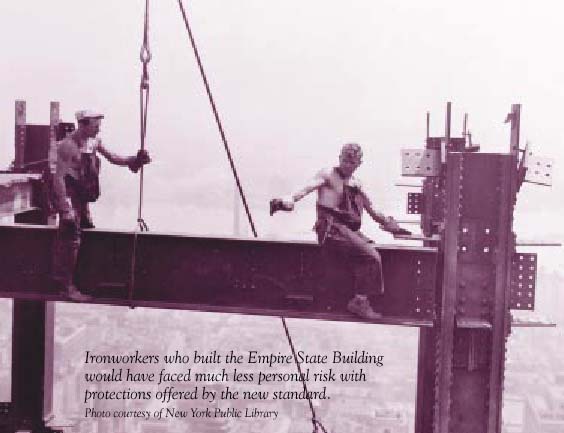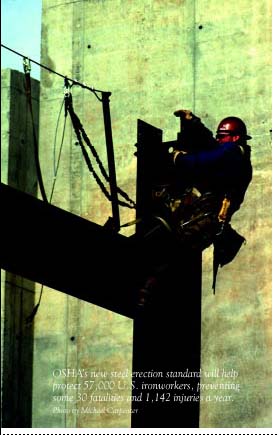Summary Statement
Describes the new 2002 steel erection standard and discusses the ways that it will make work safer for ironworkers, such as reducing falls
OSHA's new steel erection standard is expected to go a long way toward saving lives and preventing injuries.

Remember those startling pictures of workers casually walking along beams or unguardedly connecting giant steel girders hundreds of feet above the ground as they erected the world-famous Empire State Building? What many of us do not know is that five men perished during construction of the 102-story landmark.
Although we certainly have come a long way in worker safety since this architectural and engineering treasure was completed 70 years ago, the nation's 57,000 ironworkers continue to face risks of serious injury or death. Every year an average of 35 ironworkers die during steel erection activities and 2,300 more suffer lost-work-day injuries.
OSHA's new steel erection standard, which becomes effective January 18, 2002, will help make America's ironworkers safer than ever. The new standard is expected to prevent 30 fatalities and 1,142 injuries annually and, as a result, save employers nearly $40 million a year.
The rule is one of the first OSHA standards developed under the Negotiated Rule-making Act of 1990 and the Department of Labor's negotiated rule-making policy. With negotiated rule-making, a committee composed of representatives from interested parties potentially affected by the rule develops a proposed standard. OSHA then publishes the proposal, holds public hearings, and receives written information from the public. After reviewing all available evidence, OSHA issues a final standard.
Members of the Steel Erection Negotiated rule-making Advisory Committee (SENRAC) developed the steel erection rule. The committee, established in May 1994, included representatives from organized labor, industry, public interests, and government. The parties worked out contrasting positions and sought common ground through face-to-face discussions. By airing disputed issues early in the rule-making process, the committee helped to develop a better rule that employers are more likely to comply with—reducing the need for enforcement and litigation activities.
The new standard protects all workers engaged in steel erection activities. It does not, however, cover workers on electric transmission towers, communications towers, broadcast towers, water towers, or tanks.
 The revised standard
is part of OSHA's ongoing commitment to keep workplace regulations current
with evolving work practices and ensure that all workers are protected
from the hazards posed by newer working conditions and technologies. OSHA's
new requirements close gaps in current coverage, strengthen many existing
specifications, and promote compliance by clarifying and consolidating
current requirements.
The revised standard
is part of OSHA's ongoing commitment to keep workplace regulations current
with evolving work practices and ensure that all workers are protected
from the hazards posed by newer working conditions and technologies. OSHA's
new requirements close gaps in current coverage, strengthen many existing
specifications, and promote compliance by clarifying and consolidating
current requirements. The steel erection standard places special emphasis on the most serious hazards workers encounter during the steel erection process. These include hazards associated with working under loads; hoisting, landing, and placing decking; column stability; double connections; landing and placing steel joints; and falls to lower levels.
The standard's focus on these significant hazards will prevent many of the unnecessary injuries and fatalities that occur in the industry each year. For instance, a worker died in 1999 when he stepped into a 3-foot-square skylight hole and fell to the ground below. OSHA's new requirements for covering roof and floor openings might have prevented this accident. Covers for roof and floor openings must meet the following requirements:
- be capable of supporting
twice the weight of the employees, equipment, and material;
- be secured when installed to prevent accidental displacement; and
- be painted with high-visibility paint or marked with the word "HOLE" or "COVER."
According to Noah Connell, director of OSHA's Office of Construction Standards and Compliance Assistance, special provisions in the new standard concentrate on ensuring structural integrity.
"These buildings
are strong once they're completed but are very precarious while they are
being erected," explains Connell. "A number of these provisions are specifically
designed to improve the structural stability during the construction process
to prevent the buildings from collapsing or falling."
New structural stability provisions include requirements for installing
four instead of two anchor bolts to prevent "hinging down;" mandatory
testing of concrete for curing before steel columns can go up; installing
"seats" or other devices for double connections; and informing ironworkers
of modifications and repairs to anchor bolts.
In July, OSHA announced that the final steel erection standard will go
into effect January 18, 2002, exactly 6 months later than the original
effective date. The delay is designed to give the industry additional
time to become familiar with the new requirements and provide training
to employees in the construction industry. OSHA also is preparing material
to assist the industry in the training process.
The 6-month delay also allows employers time to make the necessary changes
to avoid costly prefabrication of already-made components and avoid long
delays to projects that would affect all trades involved in the construction
process. Components are typically fabricated 2 or 3 months before erection.
OSHA will not apply the component requirements of the new standard to
the following two situations:
- components used
in steel erection projects where the building permit was obtained before
January 18, 2001, when the Federal Register published the final
rule; and
- components used in steel erection projects in which the steel erection work began before September 16, 2001.
OSHA estimates that
the final rule will save employers in the steel erection industry nearly
$40 million a year in costs associated with lost-workday injuries, such
as lost productivity, medical expenses, and insurance costs. Additional
cost savings associated with avoided third-party liability claims and
other legal remedies that offer relief from economic and personal loss
are expected to be substantial.
To learn more about the steel erection standard, visit OSHA's website
at http://www.osha.gov.
JSHQ
Meilinger is a public affairs specialist in OSHA's Office of Public
Affairs, Washington, DC.
Key Provisions of the Standard
Site
Layout and Construction Sequence
- Requires certification
of proper curing of concrete in footings, piers, and walls or the mortar
in masonry piers and walls for steel columns.
- Requires the controlling contractor to provide the erector with a safe site layout, including preplanned routes for hoisting loads.
- Requires preplanning of key erection elements, including, in certain circumstances, coordination with the controlling contractor before erection begins.
- Provides additional
crane safety for steel erection
- Minimizes employee
exposure to overhead loads through preplanning and work practice requirements
- Prescribes proper procedure for multiple lifts, often referred to as "christmas-treeing."
- Provides safer
walking/working surfaces by eliminating tripping hazards and minimizes
slips through new slip-resistance requirements.
- Provides specific work practices regarding safely landing deck bundles and promoting the prompt protection from fall hazards in interior openings.
- Requires four
anchor bolts per column along with other column stability requirements.
- Requires procedures to ensure the adequacy of anchor bolts that have been modified in the field.
- Eliminates collapse hazards associated with making double connections at columns.
- Minimizes the
likelihood of lightweight steel joists collapsing by addressing need
for erection bridging and method of attachment.
- Requires bridging
terminus anchors with illustrations and drawings in a non-mandatory
appendix.
- Establishes new requirements to minimize collapse in placing loads on steel joists.
- Establishes requirements to minimize collapse in the erection of these specialized structures that account for a major portion of steel erection in this country.
- Institutes performance provisions that address hazards of falling objects in steel erection.
- Establishes controlled
decking zone (CDZ) provisions to prevent decking fatalities.
- Protects deckers
and connectors at heights greater than two stories or 30 feet. Connectors
between 15 and 30 feet must wear fall arrest or restraint equipment
and be able to be tied off or provided another means of fall protection.
Deckers between 15 and 30 feet must be protected by fall protection
equipment or work in a CDZ.
- Requires fall protection for all others engaged in steel erection at heights greater than 15 feet.
- Requires a qualified
person to train exposed workers in fall protection.
- Requires a qualified person to train exposed workers engaged in special, high-risk activities.


